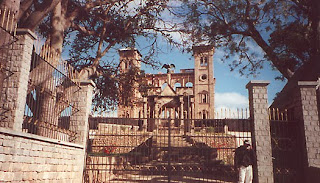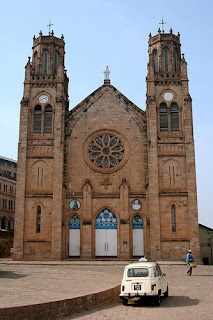
Madagascar was uninhabited until about 1500 to 2000 years ago. Portuguese, British, Dutch and French sailors visited the island, but it wasn’t until European and North American buccaneers made the island their base in the Indian Ocean in the 17th century and called it Madagascar. With the money they made from trade with other countries, many Malagasy kingdoms became powerful. At the beginning the beginning, when the chief of the powerful Merina tribe was in power, the relationship with Britain was good. But when the chief died, his wife disliked them because of their violence and killed many of the British on the island.
In 1890 the British gave France Madagascar in exchange for Zanzibar. The French captured the wife of the chief and officially colonized the island in 1897. The French constructed roads, abolished slavery, and made education better, but they also prohibited a lot of Malagasy customs, including the language. The Malagasy people did not like the French. In 1958, the island finally became independent.
Malagasy culture is a mixture of Southeast Asian, Arab, African and European. The food usually includes rice, which is typical in many Asian countries, too. The Malagasy names for seasons, months, days and coins come from Arabic. The education is not very good in Madagascar. Many adults cannot read.
The zebu, similar to a cow with a hump, is very important to Malagasy tradition and culture. It is sacred and also shows how wealthy the owner is. Cattle rustling, the moving of large groups of zebus, was a tradition when boys would become men. Zebus are also popular in art and are carved onto the wooden poles that decorate the tombs of some tribes.
About 50% of the country’s population practice the traditional Malagasy religion. In this religion, the relationship between the living and the dead is very important and they believe that when you die, you join all your ancestors in a ranking system, where the family is put in order of importance. Because of the influence of the French, today about 45% of the Malagasy are Christian, both Catholic and Protestant. But the Malagasy Christians still mix some of the traditional Malagasy religious practices with Christianity. Other religions are Islam and Hinduism.
WEDNESDAY 21ST OF JULY: Beijing- Madagascar.
The ticket costs € 1,426 per person. The flight consists of two stops. The first flight (No. 947) goes to Beijing (capital) at 20:50 to India (Indira Gandhi Intl)which arrives at 1:40. The second flight (No. 6745) goes from India (India Gandhi Intl) at 5:20 to Mauritius (S. Seewoosagur) at 11:20. The third flight (No. 289) goes from Mauritius (S. Seewoosagur) at 12:50 until Madagascar (Antananarivo) at 13:30.
Following the time zone we will arrive on Thursday.

HOTEL: La Résidence Antananarivo
We will stay in a suite. It costs 158 € and we will stay there 4 nights.
City Charges and Breakfast: City Charges and Breakfast are included in the Room Price, unless it is stated otherwise in the Services Included/Excluded information.
Services Included/Not Included: Breakfast for two persons included.A tax of 0,80 Euros per night and per room will be charged apart. Free internet access in the lobby area.Additional beds are not included in the price and cost 5 Euros per night.Stay of pets are allowed and cost 4 Euros per night.

THURSDAY 22ND
We will go to the La Résidence Antananarivo and we will leave the luggage there. Then we will have lunch in the hotel’s restaurant.
At 6.00 pm we will go to Balnéoforme Colbert, a fantastic spa with a mosaic swimming pool and Turkish bath. A variety of stunningly decorated treatment rooms offer body wraps, bubble baths and every kind of massage imaginable - relaxing, slimming, water, ying-yang… It's not cheap, but it is worth it, especially if you've just arrived back in Tana after some hard trekking.

FRIDAY 23RD
THE ROVA
The Rova, or royal palace, is the imposing structure that crowns the highest hill overlooking Lac Anosy. Gutted in a fire in 1995, it has been under restoration for years. If it has reopened when you visit, remember that it is fady (taboo) to point your finger directly at the royal tombs or the palace itself.
Minibuses 103, 134 and 190 will also take us there
MUSÉE ANDAFIVARATRA
Housed in a magnificent pink baroque palace, a few hundred metres downhill from the Rova, the Musée Andafivaratra is filled with furniture, portraits and memorabilia from the age of the Merina kings and queens.
The building was the former home of Prime Minister Rainilaiarivony, the power behind the throne of the three queens he married in succession.
+de+3174144542_9e55534296.jpg)
SATURDAY 24TH
ANDOHALO CATHEDRAL
Wind your way down to the twin-towered Andohalo Cathedral, which was built on the spot where Queen Ranavalona liked to throw Christian martyrs from the cliffs. Nearby you'll find the reconstruction of Jean Laborde's house, which served as Madagascar's first French consulate.
AVARADROVA & ANDOHALO
The districts of Avaradrova and Andohalo are fine places to stroll around for an hour or two, with stunning views on all sides, plaques detailing the significance of some interesting historical buildings and a sense of real local life around you.

SUNDAY 25TH
PRESIDENT’S PALACE
Stroll at leisure through the lanes to reach Rue Ratsimilaho, the main artery of the lively Haute-Ville. After the pretty garden on Place de l'Indépendance, head down Rue Rainilaiarivony to have a look at the President's Palace, with its sentry boxes painted red and green to match the Malagasy flag.
ANALAKELY MARKET
For Shakespeare, the entire world was a stage; for Antananarivo it seems that all the world's a market, which must make at least half the population hawkers. Everywhere you look vendors tout their wares from stalls, carts and inverted cardboard boxes, or simply wander the streets looking hopeful.
The main official market is found in the 'pavilions' at Analakely. It's a packed, teeming place, selling clothes, household items, dodgy VCDs and every food product you could imagine, plus a few things you probably couldn't - look out for the shop(s) selling '100% organic' bat guano.
No hay comentarios:
Publicar un comentario